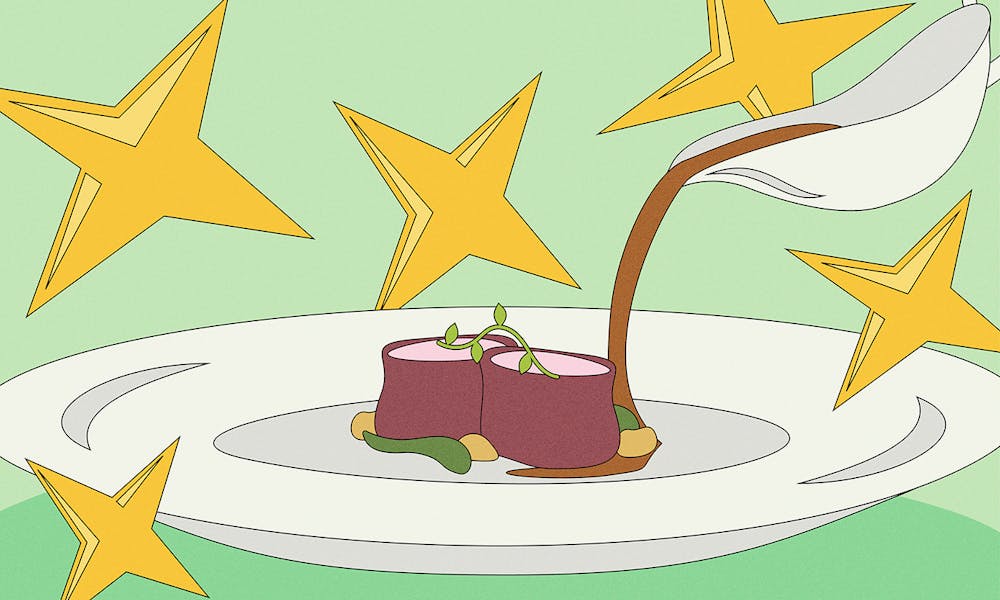The artist works rhythmically, transforming her blank canvas into a carefully curated composition through passionate yet intentional movements. She thoughtfully crafts a cohesive appeal to the senses—one that you would be hard–pressed to find hanging on a museum wall. She is not your archetypal beret–sporting, palette–holding artist. Her studio is loud and fragrant, and her work is edible. Her brushes are wooden spoons and whisks, her paints are bechamels and balsamic reductions, and her canvas is a plate. An artist of the kitchen, this chef harnesses the various sensory powers of food to make her diners salivate.
What is it about a beautiful–looking plate that makes us pick up our forks in anticipation and pull out our phones to brag on social media? The answer is simple—people like pretty things. A thoughtful presentation implies that the dish took lots of time to perfect, which solicits more appreciation from the eater and even justifies a higher price tag. A beautiful plate is associated with positive emotions that are appetizing to us and make us excited to dig in. A not–so–beautiful plate, on the other hand, comes off as boring and doesn’t stimulate the same excitement to take the first bite.

It may seem a bit bizarre to think that the way food is presented affects the degree to which it is enjoyed, especially if flavors remain unchanged. Oxford professor of Experimental Psychology Charles Spence has dedicated much of his life to resolving this conundrum through studies that test the correlation between plating and perceived taste. By giving different groups of people the same salad arranged on their plate either messily, neatly, or in a way that resembled a Kandinsky, Spence found that those who ate the artistically designed meal believed it was 29% tastier than their counterparts.
The study provides important insight into how chefs can best maximize their restaurant experience and turn Grandma’s secret recipes into five–star quality dishes. Much like the principles and elements of composition that painters incorporate into their work, chefs have their own set of tools and techniques that instantly elevate the product of their cooking. Using bold and complementary colors, strategically placing garnishes, and even playing with innovative and contrasting textures like foaminess, stickiness, or crunch are just a few tactics that chefs can employ to elevate their dishes—ultimately enhancing the gastronomical experience.
Spence has also found a scientific explanation for optimizing taste by using specific types of dinnerware. To amplify sweeter flavors, he suggests the use of white, round plates. For savory tastes, angular, black plates are the best. Colorful plates are discouraged, as they can “flavor our perception,” according to Spence. Diners may subconsciously associate certain colors with certain flavors, such as orange with cheddar cheese or green with broccoli. This may alter the way the meal in front of them is eaten.
Off the plate, ambience undoubtedly plays a critical role in the eating experience. According to Spence, bright light is preferred during the consumption of stronger flavors, while dim light is optimal for more subdued cuisines. While musical accompaniment with food is a domain worthy of much more scientific research, some findings indicate certain correlations. For example, higher–pitched sounds including wind chimes have been found to increase a diner's enjoyment of sweet foods. Likewise, lower–pitched sounds including brass are said to make savory food taste better. Factors ranging from how spaced out tables are, how comfortable chairs are, and even how warm or cold the room is can all influence how a diner enjoys their food—meaning that no element of the dining experience should be neglected.
As Spence’s findings support, nothing can stack up to the experience of freshly grated parmesan on top of your spaghetti, table–side guacamole, or those huge wooden boats many restaurants serve sushi on. When the pandemic hit, however, fine diners didn’t have much of a choice in how they ate. Restaurant lovers around the world found themselves trading fine china and the soft hum of Sinatra, small talk, and clinking glasses for cardboard containers on the couch. Carefully drizzled dressings were relegated to little plastic cups, and well–thought–out dishes became jumbled messes in Postmates drivers’ trunks.

To dress takeout dishes up, there are a couple of tips at–home diners started to incorporate into their mealtime rituals. For starters, removing the food they order from takeout containers and plating it as if they were professional chefs can boost enjoyment of the meal and partially replicate some of the restaurant experience. Setting the table rather than just eating next to stacks of mail and work could also make dining feel more sacred. Taking the time to properly reheat food instead of just shoving it in the microwave helps to maintain the integrity of the dish and prevent a sad lukewarm or soggy meal.
Some restaurants strategically adapted to the massive uptick in takeout orders in order to preserve some semblance of normalcy during these times. Do–it–yourself kits for dumplings, ramen noodles, and pizza dough help to ensure a fresh, hot meal while preserving the restaurant’s original flavors. With detailed instruction manuals to replicate the desired dish as closely as possible, families purchase a delicious meal and a fun, safe quarantine activity.
The ambience of eating in a restaurant is incredibly challenging to capture in a takeout box, but as the world slowly makes its way back to how it was prior to COVID–19, restaurateurs can get back to being artists as they curate each and every dish for the public to savor.







